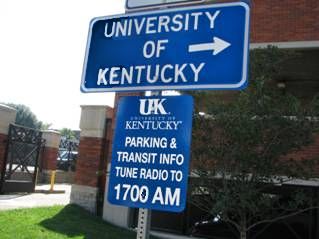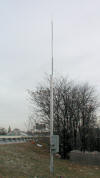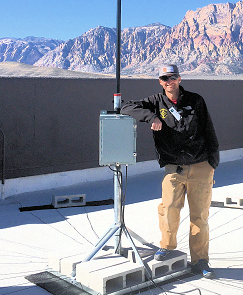| | Your Information | Your Station | Our Dedication
Introduced by the Federal Communications Commission in 1977 as a Travelers' Information Station, the Information Station is now the most installed system of its kind in the United States, with more than a thousand stations licensed to date. Its popularity stems from its versatility and affordability in a package that makes installation and operation simple and seamless. Today government agencies broadcast information to the public about emergencies, public health, airport security and border control – in addition to conventional traffic, travel and visitor information content.
Information Station Specialists is the sole provider of The Information Station in the United States and offers 24/7 remote technical support for the life of the product.
Below we describe the two styles of Information Stations, who generally operates these types of stations, licensing, antenna setup methods, what comes standard, options and last but not least ways to acquire a station. At the bottom of the righthand column, you will find links to technical specifications, planning steps and more. - USB Edition: Update the broadcast program from a simple flash drive through the station’s USB port. The USB Edition of the Information Station combines high quality 5000 Hz bandwidth with the convenience and flexibility of flash drive control. The length of the program is only limited by the flash drive size, so virtually any length and number of messages is feasible.
- IP Edition: Manage the broadcast program via an network or locally using the station’s front-panel controls. In an emergency, message files can be loaded physically via SD card with a USB adapter. The Information Station IP affords full 5000 Hz audio quality plus the convenience of a network-accessible message library.
For both editions, we offer commercially available audio creation software to allow you to create, edit and process natural voice messages for broadcast. Archive the messages on the PC, laptop or device of your choice for quick call-up. Our Hybrid Package option allows for both IP and USB methodologies, providing additional convenience and redundancy plus the addition of a program mixer for live mic / live feed applications. See free and commissioned recording services. | | Standard Package | Options | | Transmitter and digital message player in indoor electronics enclosure, containing all broadcast control electronics. See webpage. | | Complete Antenna System with lightning arrestor and weather enclosures, mounts, coaxial cable and feedlline. Compare antenna options. | | Accessories, including all hardware, wiring harnesses, etc. and illustrated instructions. | | Array of Services that includes system plannning and engineering. See services overview page. | | Remote Technical Support for the life of the station. |
| | Vertical Profile Antenna Support and Grounding System, an efficient hurricane-rated, ANSI / TIA-compliant antenna solution that saves space and installation time and is secure and attractive. See webpage. | | Hybrid Package to provide USB / flash drive redundancy and multichannel program mixer for live mic / live feed operation. | | Signal Measurement Radio Receiver to verify FCC radio signal compliance regularly. See description. | | UPS uninterruptible two-hour power supply. Extended runtime available. | | Outdoor Electronics Enclosure for isolated settings. | | Broadcast quality audio processor for enhanced audio intelligibility. | | StreamCAST Internet Audio Delivery Service that allows streaming of broadcast programs directly to smartphones, tablets, laptops and PCs. See webpage. | | Commercially available audio recording software and services such as Audacity and Adobe Audition can be used to create the audio messages. | | Message Recording Services See a descriptive webpage here. | | Flashing ALERT Signs to instruct motorists to tune to emergency stations when beacons flash. See a description of the signs here. |
View technical specifications for Standard and Optional components.
|  | | University of Kentucky listeners tune to broadcasts managed via network audio control. |
| | Who Operates the Information Station? | Federal, state and local governmental entities are able to license The Information Station to broadcast noncommercial voice-programming related to travel, public safety, visitor / tourism historical / interpretive or emergencies. The primary audience? Motorists in a 3-5-mile radius area. Operators commonly include . . . - Municipalities for example, cities, counties, townships, boroughs, towns and villages departments of public safety, emergency management, public health and public information.
Other Government Agencies for example, departments of transportation, bridge authorities, emergency management and public health departments. Recreation Areas and Historic Sites commonly use these systems for visitors. The National Park Service is among the first proponents of information station technology and is the largest nationwide user of these systems for orientation and interpretive applications. Points of Entry for example, airports, border protection, port authorities. Universities and Colleges for parking, security and venue information.
See a state-by-state list of our stations across America. | | Frequency and Licensing | | The FCC grants licenses to governmental agencies on available AM frequencies on a first-come-first-served basis, secondary to commercial broadcast stations. The Commission has opened all frequencies in the 530-1700 band, subject to separation requirements. We can help identify the optimal frequency at your location and will help you apply for your FCC license. See our Frequency and Licensing Services. | | Antenna Styles | | The most common formats are described below. Click each image below to enlarge it. | Yard Style: The Information Station antenna may be installed at a building with the electronics securely indoors and the antenna pole and groundplane located in the adjacent yard, connected by a coaxial cable. This style is a recommended first choice, because it is most economical and affords the greatest security for equipment. A 50’ separation from buildings is recommended. We can even provide the mounting pole for yard areas with limited room grounding.
|  | Flat-Roof Style: If no earth surface location is available, a flat building roof may be your best choice for antenna installation. We can provide an installation package which requires no roof penetrations.
|  |
 Isolated Style: At remote locations where there is no building, a weatherproof cabinet containing the electronics is attached to the antenna support pole. The location must have electrical power and, if equipment is to be remotely controlled, telephone or network service. Isolated Style: At remote locations where there is no building, a weatherproof cabinet containing the electronics is attached to the antenna support pole. The location must have electrical power and, if equipment is to be remotely controlled, telephone or network service.
The Information Station can be installed by you, your agent or as a service by us. Included in the package is the FCC type-accepted transmitter, digital message system, cabinets, antenna, preassembled groundplane, lightning arrestors, cables, connectors, mounts, hardware and illustrated instructions.
See "Radio Antenna Siting" for more examples. |
|
| | Planning & Purchasing Your System | We provide a full menu of technical services to help you put and keep your station(s) on the air. We will help plan and implement your station, including frequency and site selection, FCC licensing, installation, staff training and the FCC-required field survey and documentation. Even professionally recorded audio messages are available, so your broadcast is ready to put on the air as soon as the station is turned on. Best of all, each system comes with remote technical support for the life of the station.
See Typical Planning Steps and/or contact Bill Baker for a recommendation on the best setup for your intended application. Bill can also supply related pricing.
See Purchasing Methods here.
Note: Because FCC processing time is unpredictable, we recommend that you request licensing and other FCC documentation services from us as soon as you know for sure you will have a station – definitely no later than when you place your radio equipment order.
For more features see the ALERT AM Emergency Advisory Radio System. For extended range emergency broadcasting, see RadioSAFE Wide Area Emergency Broadcast Radio Systems, which offer coverage areas of a 5 to 20+ mile radius. For lower cost alternatives and less range, see our License-Free Offering. |
|  | | Fireman Erik Olson poses near a new visitor center antenna system he helped install for the Bureau of Land Management's Red Rock Canyon National Conservation Area near Las Vegas, Nevada. We are told that the system works better than advertised. | | | | CUSTOMER REVIEWS | | “We have already gotten many positive and enthusiastic responses. We are very happy we decided to do this!" | Lauren Fenstermacher, Manager
Middle Creek Wildlife Management Area Visitor Center Pennsylvania Game Commission | | | | “The signal quality is amazing, far better than I thought, with no static. I am very pleased. Thank you, this is an amazing tool!” | Alexander Watson, Regional Naturalist
Minnesota DNR Parks and Trails | | | First National Network of Info Stations
Customs & Border Protection | CBP installed Information Stations at key land border ports of entry, providing information to approaching motorists with the intention of expediting their passage across the border, i.e., El Paso, Laredo, TX; San Luis, AZ; and Calexico (East), CA. Additional sites are planned.
The stations broadcast time-sensitive messages developed at the local ports of entry, in addition to messages developed at the national level by CBP Headquarters.
Project manager Daniel Piscopo states that the broadcast messages include “how to use high-tech travel cards, information about CBP's Trusted Traveler Programs, basic border crossing rules and regulations, emergency travel information and updates, and border wait times.”
CBP will be able to communicate directly to travelers about how to expedite their border crossing, for example, by broadcasting information about CBP programs such as the Ready Lane — an expedited travel lane for people with radio frequency identification technology enabled cards -- and Trusted Traveler lanes for pre-approved, low-risk travelers.
Radio broadcasts can be heard for several miles around the port. |
| | | | RELATED LINKS | | Brochure | | System Specs | | Planning Guide | | Technical Services |
|

